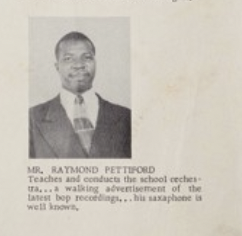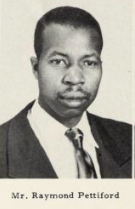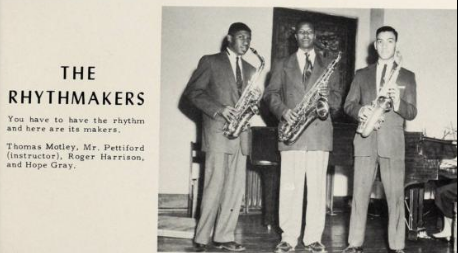
Palmer Institute’s 26-piece 1953 band marked the school’s 32nd year of instrumental instruction. Palmerite 1953. DigitalNC.org.
Raymond Pettiford, tenor saxophone
A Greensboro native, Raymond Pettiford was one of 9 Dudley High School students who joined B-1 with their bandmaster, James Parsons, before their senior year was completed. He majored in music and began teaching band at local schools before he graduated from A&T in 1951 and soon after began teaching at Palmer Institute in Sedalia, which he recalled as “a real fine all around polished school.”
On his early musical interests, he said, “I liked Duke Ellington’s band, I liked the players from Duke Ellington’s band. He had Walter Thomas and also Chu Berry on tenor sax, and I thought they were great musicians.”
He also married and had four children, which made it easy to give up the idea of traveling to play music: “I couldn’t cope with the night life, the one-night stands, moving from town to town, trying to find a place to stay, different things like that and traveling made it really hard.”
During the summer of 1947, Tabu Mike stayed with him and his family, and Pettiford was a regular with the Rhythm Vets and at the Artists Guild until he married. He continued to play local dates with the Max Westerband orchestra into the early 1970s.
He especially enjoyed playing at the Guild, which “had different rooms with different settings–like a Chinese Room, a Mexican room, in other words, the paintings in each room would be like that–a French room, with all the glass and everything.”
He recalled John Warner’s visit to A&T to meet the band, and his leaving music with them to practice before they came to Greenville for the soundtrack recording. He was the only Vet to mention additional recordings, most likely because they remained in his possession: “The recording was done on a large record, cut on a master, ran from inside out. It was a metal record. You had to brush it off. I know we did a couple of records after the session. Tabu was singing on one. I had those records once but I don’t know what happened to them.”
His memory of playing behind three singers in Greenville fits with a scenario that would find Tabu Mike joined by locals Esther Mae Porteur and Joe Little singing while the band played, as opposed to the band playing while watching film of a singer.

1956 Palmerite. DigitalNC.com
He also thought the dancing in “Pitch” reminded him of the dancing he kaccompanied on a brief job he’d worked in the summer of 1946: He and Frank Williams played Reidsville, High Point, and other local towns with a medicine show whose name he’d forgotten. “We got about $15 a week,” he said. “The finale in the film was the same thing. They sold a tonic like stuff in a bottle like alcohol, sold for $2. They had a large tent, two shows a night, and the numbers were different, the acts were slightly different in each. On certain songs they needed sheets, so they need readers. They had about five bandsmen that traveled with them and they picked up three of us to replace three that had quit. They rented this big vacant lot had a great big tent. We didn’t want anyone to know we were playing with them. They sold this Cracker Jack-type box, cost a dollar, the prize would be in the box. It was more comical to us than anything. They had a few dancers, two or three tap dancers; two or three said they had played with Silas Green.”

1956 Palmerite, Palmer Memorial Institute’s annual. DigitalNC.com
But he eventually had to give up playing completely because of troubles with his vision. “I liked the playing,” he said. “It was the pressure that bothered me to change my mind. Going club to club, playing every night, I started having trouble seeing. Doctor told me to stop, but I didn’t. The reason I can’t play now is a piece of nerve that blocked my vision–my vision is less than three feet; in other words, I had to stop playing in order to maintain the eyesight that I have. Still my vision is less than three feet.”
• • •
Sources
Pettiford, Raymond. Telephone interview. 5 Apr. 1986.
—. Personal interview. Greensboro, NC. 25 July 1986.
—. Personal interview. Greensboro, NC. 16 July 1987.
—. Personal interview. Greensboro, NC. 3 Aug. 1987.